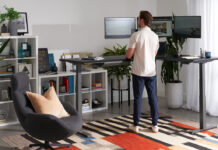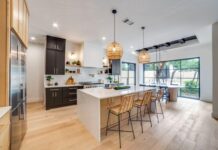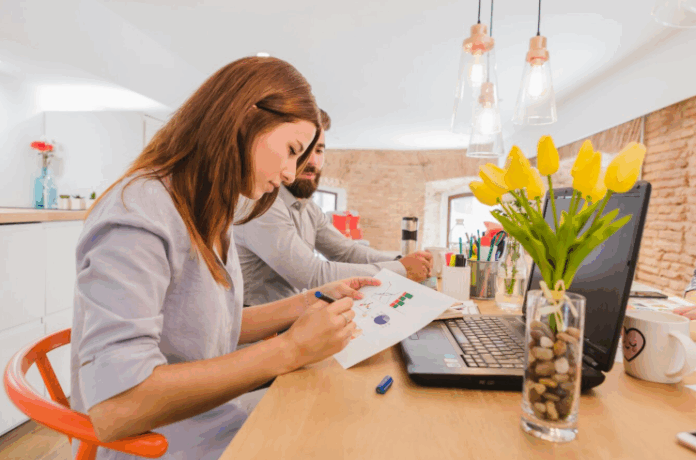Your home and workplace surroundings directly affect your mood, productivity, and creativity. A thoughtfully designed environment can lift your energy, reduce stress, and make daily work feel more meaningful.
According to the 2023 Gensler U.S. Workplace Survey, only 12% of remote workers say their home workspace is ideal for productivity. Workplace strategist Kate Lister explains:
“The environment around you influences not just how you work—but how well you feel doing it.”
Whether you’re working from your living room or a shared office, optimizing your home and workplace design helps create an atmosphere where you can thrive.
Let us dive into easy, budget-friendly design upgrades that make a huge impact—no interior design degree required.
Understanding the Connection Between Home and Workplace Environments
In 2026, hybrid work is the new normal, blending home and office environments. A thoughtfully designed home-office ecosystem:
A well-planned home and workplace setup can:
-
Improve concentration and motivation
-
Support physical and mental wellbeing
-
Reinforce boundaries between work and relaxation
Research Insight: According to Steelcase, workers in ergonomically optimized home offices report a 20–25% increase in productivity and significantly lower physical discomfort.
Let’s explore practical ways to make your surroundings truly inspiring.
1. Start with Natural Light
Natural light is one of the most powerful design tools. Studies show it improves focus, mood, and sleep quality.
-
Position your desk near a window to soak in sunlight.
-
If natural light is limited, use warm LED bulbs instead of harsh, blue-toned lights.
-
Add mirrors to reflect light and make your space feel larger and brighter.
Cornell University study: Natural light can boost productivity by up to 15%.
2. Declutter for Mental Clarity
A cluttered space leads to a cluttered mind. Keeping your home and workplace organized enhances decision-making and creative thinking.
Daily Routine:
-
Spend 10 minutes tidying a small area, like your desk or shelves.
-
Digitize documents to minimize paper clutter.
Benefits:
- Lower stress and mental fatigue
- Improved focus
- Faster problem-solving
3. Personalization: Make Your Space Truly Yours
Personalized spaces strengthen emotional connection and intrinsic motivation. Incorporate elements that resonate with your personality and values.
Suggestions:
-
Framed quotes or artwork that inspire
-
Indoor plants to improve air quality and well-being
-
Unique lighting, rugs, or decor to create a sense of comfort
Research shows personalized workspaces can increase creativity by up to 40%.
4. Create Distinct Zones for Work and Relaxation
Even compact spaces benefit from clearly defined work and leisure zones. This helps your brain switch between task-oriented and relaxation modes.
Implementation Ideas:
-
Use rugs to designate work areas
-
Install bookshelves or partitions for separation
-
Utilize foldable or movable desks for flexibility
Expert Tip: Sarah Thompson, Interior Design Consultant, notes:
“Separating functional zones reduces cognitive overload and promotes mental balance.”
5. Ergonomics: The Core of Productivity
Ergonomic design is essential for comfort, health, and sustained performance. Poor posture and strain reduce productivity over time.
Small but Impactful Adjustments:
-
Lumbar support pillows or ergonomic chairs
-
Laptop risers or adjustable monitor stands
-
Wireless keyboard and mouse for reduced strain
Steelcase Research: Proper ergonomics can decrease absenteeism by 20–25%.
6. Apply Color Psychology Strategically
Colors influence emotion, energy, and concentration. Use them intentionally in home and workplace design:
| Color | Psychological Effect | Best For |
|---|---|---|
| Blue/Green | Calm, focus, creativity | Deep work, analytical tasks |
| Yellow | Optimism, innovation | Brainstorming, creative sessions |
| Red | Energy, urgency (use sparingly) | Short-term high-energy projects |
| White/Gray | Clean, modern, minimalistic | Background balance; combine with warm tones |
7. Think Vertical: Smart Storage Solutions
If you’re short on space, go upward. Use shelves, wall organizers, or vertical storage racks. This frees up surface space while keeping essentials within reach.
Try:
-
Floating shelves above your desk
-
Pegboards for tools or supplies
-
Wall-mounted lighting to save table space
Vertical design keeps your home and workplace neat and functional.
8. Engage the Senses: Sound and Scent Matter
Sound and scent subtly influence your mindset.
-
Play soft background music or nature sounds.
-
Use essential oils like lavender (for calm) or citrus (for energy).
-
Add textured fabrics for tactile comfort.
Small sensory details help your space feel more human and inspiring.
9. Flexible Layouts for Dynamic Work styles
Flexibility allows you to adapt your workspace to different tasks and moods.
Examples:
-
Portable laptop stands and rolling trolleys
-
Foldable seating and adjustable desks
-
Modular furniture for collaboration or solo work
Expert Insight: Flexibility in workspace design enhances productivity and supports hybrid work routines.
10. Avoid Common Design Mistakes
Overusing neutral tones (can feel cold)
Poor lighting that causes eye strain
Ignoring ergonomics
Mixing too many décor themes
Rule of Thumb: Focus on balance, simplicity, and functionality, not perfection.
Latest Trends in Home and Workplace Design (2026)
-
Hybrid-Friendly Workspaces – offices blending remote and in-office work setups.
-
Eco-Friendly Design – sustainable materials, energy-efficient lighting, and greenery.
-
Smart Office Technology – AI-powered lighting, noise-canceling zones, and productivity apps.
-
Flexible Layouts – modular furniture that adapts to meetings or solo focus work.
-
Wellness Corners – meditation areas, standing desks, and quiet pods.
Case Study: A remote startup revamped employee home offices with natural light, ergonomic chairs, and personalized decor, resulting in 30% higher focus and fewer absences..
In Essence
FAQs
1. How can acoustics be managed in a combined home-and-workplace setup?
You can reduce noise with sound-absorbing panels, carpets, and curtains. Rearranging furniture against walls also helps minimize echoes. Noise-canceling headphones are a simple fix for shared spaces.
2. What lighting setup minimizes eye strain and improves mood for both home and workplace tasks?
Use a mix of natural light, task lighting, and warm LEDs. Position desks near windows to reduce glare while ensuring even brightness. Adjustable lamps let you control light intensity throughout the day.
3. How do I maintain work-life balance when both work and home share the same space?
Create physical or visual boundaries, like room dividers or dedicated desks. Stick to regular work hours and schedule breaks. This separation helps you mentally “switch off” after work.
4. What are eco-friendly design choices for a home and workplace setup?
Choose bamboo, reclaimed wood, or recycled metal for furniture. Opt for energy-efficient lighting and low-VOC paints. Adding indoor plants improves air quality while creating a calming space.
5. How can technology be integrated into home/workplace design without clutter?
Use cable organizers, wall-mounted chargers, and wireless devices. Smart plugs and hidden power strips keep setups tidy. Integrating tech into furniture helps balance functionality with style.
Find a Home-Based Business to Start-Up >>> Hundreds of Business Listings.














































